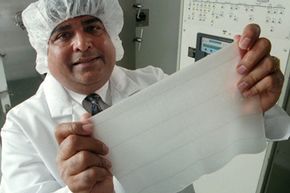Growing Skin in a Lab: The Epidermis
The artificial skin membrane developed by Burke and Yannas made it easier to apply skin grafts to a burn victim, but there was still the challenge of where to get the new skin. Doctors could cut skin from another part of the patient's body, stretch it and perform a transplant, but this painful procedure wasn't an option for patients who didn't have enough skin left to use. Doctors also tried using skin from cadavers, donors from the victim's family and even other species, but the patient's immune system usually rejected these grafts. They couldn't simply give burn victims an increase of immunosuppressants, either, as they're already so vulnerable to infection.
Researchers have had success growing new skin from the patient's own skin cells. If a patient's feet are unburned, for example, some skin cells in that area can be biopsied and sent off to a laboratory, where they'll grow thanks to nutrient feedings and multiple divisions. The process takes a few weeks, but eventually the cells will divide until they've created a sheet of skin 100 times the size of the original sample [source: Singer]. While skin cells that keep dividing are cancerous, the skin sheets have so far returned to normal once engrafted. Sometimes, the lab-grown skin is treated with an antibacterial protein to reduce the risk of infection while increasing the chance of transplant success.
Advertisement
Another source of new skin comes from a source that's usually designated for the waste bin: the foreskin of a circumcised infant. A piece of foreskin the size of a postage stamp can produce approximately 4 acres of skin tissue in the laboratory [source: Strange]. Artificial skin derived from foreskins is thought to be successful when donor skin is not because the newborns' cells don't rouse the host's immune system; if they did, mothers' bodies would reject fetuses [source: Skloot]. Foreskins are also sometimes used to create the structural framework for the dermis.
The lowered risk of infection is vital to the success of lab-grown skin; another plus is that the process results in minimal scarring. Patients regain most sensations from nerve endings, and if the burn victim is a child, the new skin will grow with the patient as he or she ages. Still, the process is not yet widespread and has a few difficulties to overcome: For one, the skin cells divide in the lab fairly slowly. The sheets of skin that leave the lab must be used almost immediately, yet they are so fragile that they can be difficult to transport. The lab-grown skin is also expensive; a 2001 article claimed that an 8 by 10 inch (20 by 25 centimeter) sheet of skin cost $2,000 [source: Smith].
Fortunately, many people and companies are working to address these issues. For example, German research organization Fraunhofer-Gesellschaft has announced plans to grow skin from the stem cells in human hair and create an automated production line process for manufacture [source: Fraunhofer-Gesellschaft].
Related HowStuffWorks Articles
- How Face Transplants Work
- How Biomechatronics Works
- Can people get bone marrow transplants from baboons?
- How do broken bones heal?
- How can scientists use an inkjet printer to make bones?
- How can salamanders regrow body parts?
Sources
- Altman, Lawrence K. "Artificial Skin for Burn Victims is Reported Developed in Boston." New York Times. April 24, 1981. (July 27, 2009)http://www.nytimes.com/1981/04/24/us/artificial-skin-for-burn-victims-is-reported-developed-in-boston.html
- "Artificial Skin Developed at MIT Now Ready for Treatment with Burn Patients." Massachusetts Institute of Technology. April 12, 1996. (July 27, 2009)http://web.mit.edu/newsoffice/1996/artificialskin.html
- Carvajal, Doreen. "Growing artificial skin to change how cosmetics firms test products." New York Times. Nov. 16, 2007. (July 27, 2009)http://www.nytimes.com/2007/11/16/business/worldbusiness/16iht-WBCELL.1.8363140.html
- Casselman, Anne. "Beauty Sans the Beast." Discover Magazine. November 2007. (July 27, 2009)http://discovermagazine.com/2007/nov/beauty-sans-the-beast/
- Fisher, Lawrence M. "3 Companies Speed Artificial Skin." New York Times. Sept. 12, 1990. (July 27, 2009)http://www.nytimes.com/1990/09/12/business/business-technology-3-companies-speed-artificial-skin.html
- Fraunhofer-Gesellschaft. "Artificial Skin Manufactured in Fully Automated Process." ScienceDaily. May 19, 2009. (July 27, 2009)http://www.sciencedaily.com/releases/2009/05/090518102959.htm
- Fraunhofer-Gesellschaft. "Growing Artificial Skin From Hair Roots." ScienceDaily. Jan. 4, 2008. (July 27, 2009)http://www.sciencedaily.com/releases/2008/01/080104140344.htm
- Fraunhofer-Gesellschaft. "Production Line for Artificial Skin." ScienceDaily. Dec. 10, 2008. (July 27, 2009)http://www.sciencedaily.com/releases/2008/12/081209100838.htm
- Hilts, Philip J. "Skin Grown in Lab Offers New Hope for Burns and Unhealable Wounds." New York Times. June 28, 1995. (July 27, 2009)http://www.nytimes.com/1995/06/28/us/skin-grown-in-lab-offers-new-hope-for-burns-and-unhealable-wounds.html
- McCarthy, Michael J. "Fateful Decision: After Horrific Burn, A Wife's Choice." Wall Street Journal. April 29, 2005.
- Singer, Emily. "A Better Artificial Skin." Technology Review. Jan. 12, 2007. (July 27, 2009)http://www.technologyreview.com/biotech/18059/
- Skloot, Rebecca. "Immortal Skin." Popular Science. Dec. 13, 2001. (July 27, 2009)http://www.popsci.com/scitech/article/2001-12/immortal-skin
- Smith, Carol. "Artificial Skin Offers Genuine Hope." Seattle Post-Intelligencer. Feb. 23, 2001, (July 27, 2009)http://www.seattlepi.com/local/burn231.shtml
- Strange, Carolyn J. "Brave New Skin." Technology Review. July 1997.
- Strange, Carolyn J. "Second Skins." FDA Consumer. January/February 1997.
- "The Development of Artificial Skin." Massachusetts General Hospital Burn Research Center. (July 27, 2009)http://www.burnresearchcenter.org/brcpublicwebsite/artificialskin.htm
- "Treating Severe Burns with Artificial Skin." National Institute of General Medical Sciences. July 2008. (July 27, 2009)http://www.nigms.nih.gov/Publications/Factsheet_ArtificialSkin.htm
